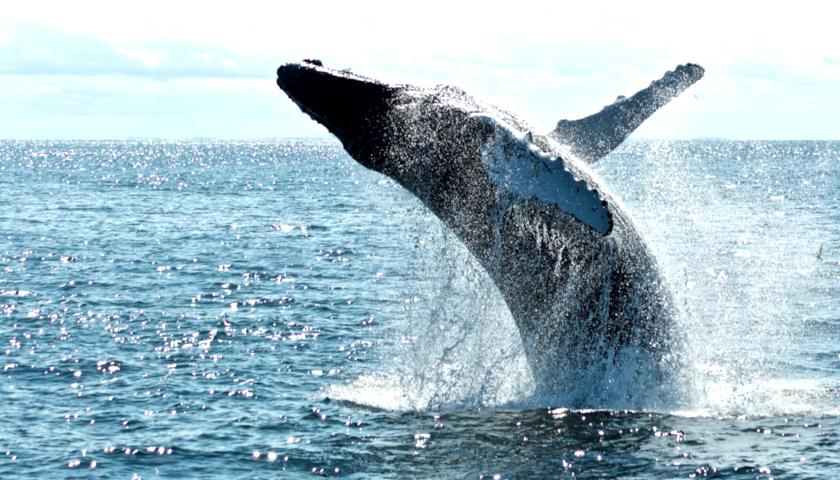by Edward Ring
The oceans director of Greenpeace told USA Today that groups attempting to link offshore wind to whale deaths are part of a “cynical disinformation campaign.”
– Whale carcasses on Martha’s Vineyard fuel speculation about wind turbines, New Bedford Light, June 22, 2023
If you want to know just how far the environmentalist movement has fallen in recent years, the destruction of marine life off the coast of Massachusetts in 2023 provides a disgraceful example. Greenpeace, an organization that not only led the earliest vanguard of the modern environmental movement, but was specifically formed to save the world’s whales, is actively denying what is likely the most egregious massacre of whales by Americans in more than a century.
Greenpeace is not alone. This shameful demonstration of mass deceit is on full display by all the organizations that supposedly exist to protect wilderness and wildlife, along with the media that marches in lockstep with their every whim. As usual, a Google search turns up a nearly monolithic edifice of articles decrying the “anti-renewables” lobby for their “misinformation.” From Time Magazine, “conspiracy theorists think wildlife groups are covering up whale deaths.” From FactCheck.org, “No Evidence Offshore Wind Development Killing Whales.” From CBS News, “No known connections between wind power and whale deaths.” From the US Department of Energy, “Addressing Misinformation on Offshore Wind Farms and Whale Deaths.” From NPR, “Dead whales on east coast fuel misinformation about offshore wind.” And on and on it goes. The same story. The same disinformation. Everywhere.
The fact that so many so-called authoritative sources could engage in a coordinated campaign of denial is not new. But their willingness to make these assertions in the face of such compelling evidence to the contrary, and in such contradiction of the environmentalist values they all ostensibly share, indicates a new low for America’s controlled media, and the cowards it employs.
The only charitable explanation is that the urgency of the “climate crisis” has addled the minds of journalists that ought to have enough common sense, or courage, to acknowledge the obvious. When you detonate massive explosives, repeatedly drive steel piles into the ocean floor with a hydraulic hammer, and blast high decibel sonar mapping signals underwater, you’re going to harm animals that rely on sound to orient themselves in the ocean. To say it is mere coincidence that hundreds of these creatures have washed ashore, dead, all of a sudden, during precisely the same months when the blasting and pounding began, is brazen deception.
A recent and scathing set of articles published over the past few weeks by Michael Shellenberger on his Substack account provide some excellent examples of how misguided environmentalism, specifically with respect to the environment, is doing far more harm than good. He is one of the only journalists in America to report honestly on the cause of whale deaths.
Shellenberger offers additional examples of misguided environmentalism. He exposes the fraudulent essence of most plastic “recycling,” wherein the plastic, painstakingly sorted by consumers and collected at considerable extra cost by overbuilt waste management companies, ultimately ends up not being recycled. The recycler “instead ships the waste to poor nations, where it ends up in rivers and oceans.” Shellenberger also points out the sordid symbiosis between misguided environmentalism and woke ideology, using as an example perhaps one of the most infamous men in the world today, the arrogant M. Kaleo Manuel, who denied water to Maui firefighters during the hours when lives might still have been saved, because “he would be willing to consider doing so but only after he and they had ‘true conversations about equity’.”
There’s something else at work, however, bigger than climate crisis panic, and bigger than woke ideology, that has turned the environmentalist movement into a monster that often does more harm than good. The environmentalist movement has been hijacked by financial special interests. In the office towers of Boston, attorneys, developers, and politicians today are slavering with lust over the billions in fees, subsidies, and donations their firms, their companies, and their campaigns will collect as they deploy offshore wind energy atop the carcasses of humpback whales. “Offshore wind is for the greater good, because it’s going to save the planet from extreme weather,” is their unassailable public argument, as the cynics among them laugh at all the gullible suckers.
“Clean technology” is a good idea, but often horrific in practice. There’s nothing remotely competitive about offshore wind energy, although you’ll have to work awfully hard to find anything but pollyanna prognostications in a Google search. But a well researched article published earlier this year by David Turner, “Exploding the Cheap Offshore Wind Fantasy,” exposes the inconvenient truths about this destructive boondoggle. The corrosive power of saltwater and salt-laden sea air make maintenance of offshore turbines an expensive proposition that only increases over time. Accessing these turbines for maintenance is impossible during heavy storm events when repairs are often most needed. Turner estimates the useful economic life for these fabulously expensive leviathans at a mere 12 years.
Equally daunting facts surround the actual productivity of these offshore wind farms. The biggest offshore turbines currently available generate 10 megawatts. They stand over 1,000 feet tall and require about one square mile each in order to maximize efficiency by not cannibalizing wind needed to drive nearby rotors. Even if the offshore wind blows 50 percent of the time, and no study however optimistic and supportive of wind energy has ever predicted a higher yield, this means each one will provide – once you’ve installed storage assets and transmission lines at stupefying additional cost – 5 megawatts of baseload power. If that sounds like a lot, it’s not.
New England’s electricity demand averages around 25 gigawatts in 2023. Bear in mind this demand will increase not by increments, but by multiples, if and when New England – along with the rest of the nation after the great green reset – electrifies much of its transportation and residential sectors. For offshore wind turbines as described to provide 25 gigawatts of baseload electricity, five thousand of them would have to be built. Imagine how these billions might be better spent. And kiss the whales goodbye.
These examples just scratch the surface of how thoroughly environmentalist extremism, represented as no vice when in defense against the climate crisis, is actually harming the environment. Ask the orangutans of Borneo, casualties along with countless other species as rainforest gives way to palm oil plantations for biodiesel. Ask the jaguars of Brazil, as rainforest on that side of the world is incinerated in order to become carpeted with sugar cane plantations to produce ethanol. As Californians import biodiesel in ships powered by bunker fuel, virgin land is seized and stripped, its ecosystems decimated with biofuel monocultures saturated with pesticide and petroleum-based fertilizer. So far over 550,000 square miles have been given over to biofuel farming, in exchange for making less than a 2 percent dent in the global supply of petroleum based transportation fuel.
These are the excesses of environmentalism today. To put a human face on this catastrophe, consider the trafficked and enslaved children toiling in the Chinese owned cobalt mines of West Africa, so virtue signaling dweebs can drive 6,000 pound, resource guzzling EVs on American streets that were never designed for so many heavyweight vehicles. For that matter, on a topic that only seems unrelated, consider the millions of Americans that can’t afford homes, because environmentalist policies are enforcing “greenbelts” around every major urban area, limiting supply and driving up prices.
For these and numerous other examples of greed masquerading as green, there is big money talking, right alongside big power. Environmentalism in 21st century America has very little to do anymore with the environment. Those millions of Americans who can remember when Greenpeace actually cared about saving the whales need to realize that brand equity was squandered and discarded, a long, long time ago.
– – –
Edward Ring is a contributor to American Greatness.









News flash. Anyone using the terms “Going Green” “Green Energy” or having been caught up in the Ecco Terrorist movement has been duped by a play on words. Green refers to the money not the environment. Not unlike the “Manuel” (Manual) program employed by the Haslam Family “Pilot Empire” to defraud unsuspecting trucking companies and most likely the US Postal Service by charging a few pennies more per gallon to unsophisticated customers.
These people, and I include the current traitor occupying the White House are hell bent on bankrupting this country and gathering every monetary system unto themselves. All under the guise of some horrific impending event that will never occur.
The term “follow the money” will never go out of style.